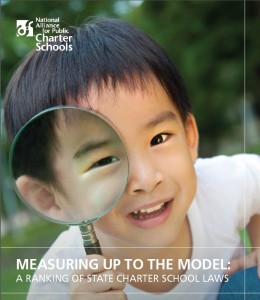 Florida continues to score well in an annual ranking of charter school laws in states around the country. It keeps its eighth-in-the-nation ranking in the latest analysis of state charter school laws released by the National Alliance for Public Charter Schools, and its score remains the same after a year in which state charter laws didn’t see major changes.
Florida continues to score well in an annual ranking of charter school laws in states around the country. It keeps its eighth-in-the-nation ranking in the latest analysis of state charter school laws released by the National Alliance for Public Charter Schools, and its score remains the same after a year in which state charter laws didn’t see major changes.
The state gets high marks for not placing caps on the number of charter schools allowed. It also scores well for balancing autonomy and accountability, and for having an appeals process for schools whose applications are rejected.
The report notes two areas where Florida could improve its standing: Funding equity, and authorizer accountability. Constitutional and funding constraints mean making improvements in those areas could require some creativity.
The issue of accountability for charter school authorizers has also been raised by the National Association of Charter School Authorizers, a group aiming to improve the quality of charter schools.
The trouble in Florida is that school districts are, by and large, the only game in town when it comes to authorizing (a handful of charter schools are authorized by universities). The state constitution gives school boards the authority to regulate all public schools within their districts, making it harder to create alternative authorizers such as a board run by the state.
That hasn’t stopped state officials from taking some steps to improve district authorizing by creating guidelines for charter school oversight. The authorizers association had additional suggestions, like requiring the state to publish annual reports on the performance of the charters each school board approves.
The charter alliance’s report also suggests Florida provide “equitable access to capital funding and facilities.” This has been the topic of heated legislative debates and contentious state commissions, but charters still rely on year-by-year appropriations through the state’s Public Education Capital Outlay. This pits them in yearly lobbying battles with colleges and universities (which, like charters, can’t levy taxes) and school districts (which can levy local taxes to pay for school facilities, but often have older buildings and more stringent building specifications, class-size limits, and the like).
Charter school advocates have said they need a reliable source of revenue that will remain steady year over year. Some school district leaders have agreed they would prefer not to have to compete with charters for scarce facilities funding each year. But the question remains: What should the source of that funding be?
The answer isn’t obvious, and the report makes clear that facilities funding is a challenge for charter schools around the country. It’s even an issue in Minnesota, the state with the top-ranked charter school laws.


